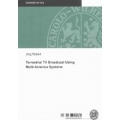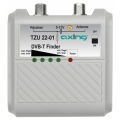Terrestrial TV Broadcast Using Multi-Antenna Systems
State-of-the-art terrestrial broadcast standards such as DVB-T2 have already closely approached the theoretical performance limits for single-antenna operation. Hence, additional significant improvements of the payload bit-rate at comparable channel conditions are impossible in such single-antenna systems. One remaining candidate for further bit-rate improvements is the application of multiple antennas on the transmitter and/or the receiver side, as already implemented in state-of the-art point-to-point communication systems. This thesis focuses on the potential enhancements of using such multi-antenna algorithms in classical TV broadcast networks. For this purpose, the thesis gives an introduction to the mathematical fundamentals of multi-antenna systems and selected multi-antenna algorithms. An important finding is the fact that the number of transmit and receive antennas does not fully classify a multi-antenna system. The number of linearly independent layers has to be considered, too. Considering the limitation in terrestrial TV broadcast networks, algorithms required for the decoding of broadcast signals with up to two linearly independent layers are discussed. For analysing the potential benefits of multi-antenna systems, three main scenarios for the application of multi-antenna algorithms in classical TV broadcast networks are presented. The performance of the system proposal in the three different scenarios is then analysed in detail by means of simulations. Unlike most previous work, the comparison criterion is not based on the bit error rate after the forward error correction, as this does not sufficiently describe the user's experience. Instead, the performance is compared using the outage probability. The simulation results indicate that the application of multiple antennas provides a significant gain. However, most of this gain is already achieved when using a single layer, i.e. by means of classical diversity techniques. Therefore, most of these improvements may be obtained by using already existing standards as e.g. DVB-T2. Only Multi-User like MIMO transmission offers an interesting gain.





